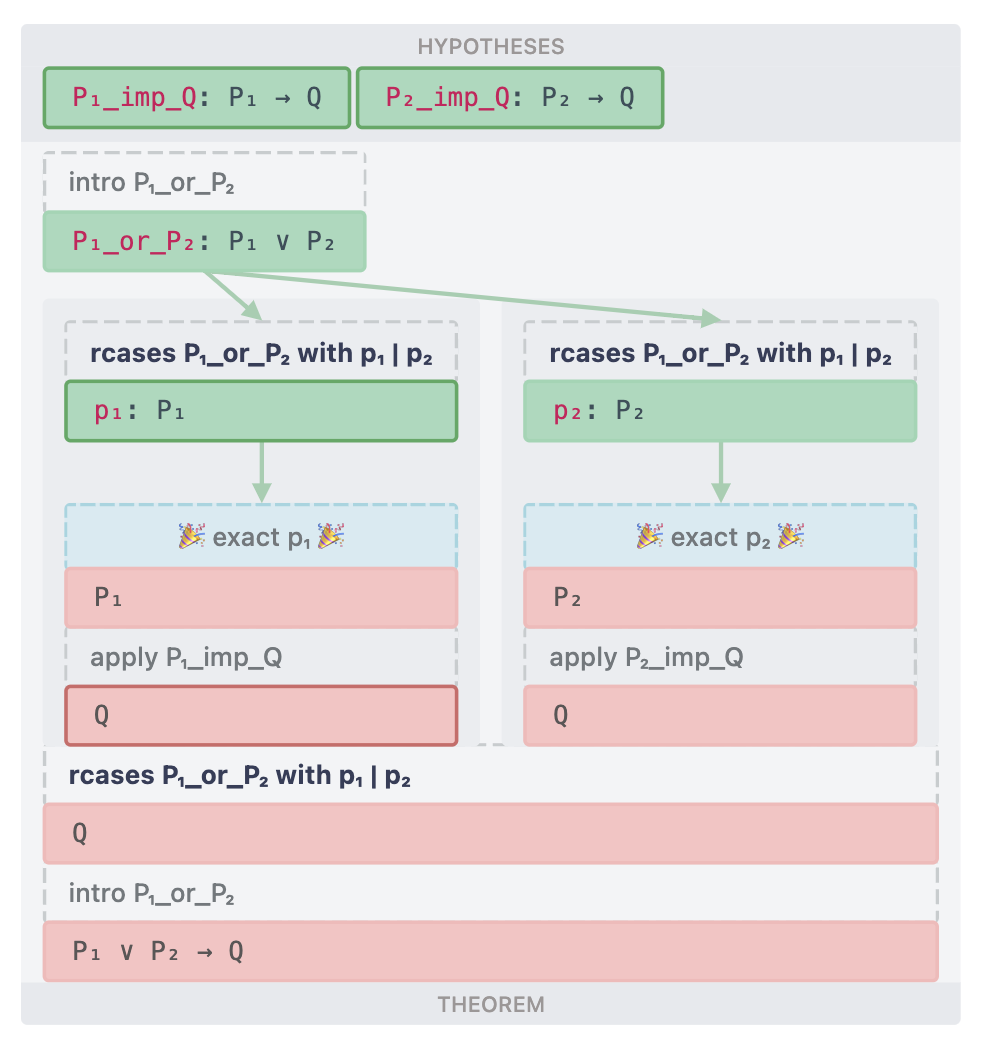Type theory
- Has been developing for more than a century: Russell (1905), Church (1941), Martin-Löf (1973), Voevodsky and collaborators (2013).

- Emerges from logic, in particular the rules of natural deduction (Gentzen).
- Can serve as a foundation both for mathematics and for programming languages.
- The Lean system is incompatible with Voevodsky's univalent mathematics.
Propositions-as-types / Proofs-as-programs
- Often referred to as the Curry-Howard correspondence.

- Fundamental aspects:
- Mathematical concepts are represented as types (and proofs as terms).
- The logic is not postulated oustide the theory: it is intuitionnistic (introduced in the language itself) and constructive (no axioms).
- In Voevodsky's approach, types are viewed as spaces / homotopy types.
An example
- An implication
- In general, we only have
example {P Q : Prop} : (¬P ∨ Q) → (P → Q)
| Or.inl (notP : ¬P) => fun (p : P) ↦ False.elim (notP p)
| Or.inr (q : Q) => fun (_ : P) ↦ q
- Here,
Mathematical structures
- Martin-Löf's type theory is often referred to as dependent type theory (as opposed to Church's type theory, which is sometimes referred to as simple type theory).
- Properties such as the commutativity of a ring can be represented quite naturally using dependent types.
- In this approach, a commutative ring is a pair
⟨R, mul_comm⟩whereRis a ring andmul_commis a proof that the multiplication operation ofRis commutative.
structure CommRing where
R : Ring
mul_comm : ∀ x y : R, x * y = y * x
- Note how the type representing the commutativity property depends on the term
Rintroduced one line above. A ring is itslef a a tuple⟨S, +, add\_assoc, 0, ... ⟩.
A visualization challenge
-
In the 2024 HEGL seminar, the first half of the semester was dedicated to learning the concepts we have just discussed, and what it implies for basic concepts of algebra.


-
The students were then asked to write a Lean proof that, in a domain, every prime element is irreducible, and to turn that proof into a game.
The pen-and-paper proof
- Mines, Richman and Ruitenburg tell us that the natural setting for the proof of prime
.
- Assume that
- Since
- If
- Similarly, if
- If
- As we shall see, the Lean proof is much longer! We can see it in Lean4Web, where we can also modify it.
Paperproof
- Paperproof is a VS Code extension that gives a visual representation of a Lean proof.
- The highlighting changes as one scrolls down the proof.

The game interface
- A game consists of several worlds, and each world of several levels. We created our levels by splitting the proof that irreducible
- Thanks to the interface, we can provide hints and explanations via clickable links.

Feedback / Next steps
On the up side:
- The students were engaged and participating actively the whole semester (not just for their own talk).
- Writing a game is a good way to get acquainted with the use of a proof assistant.
On the down side:
- Lean's syntax is difficult to grasp at the beginning and this can hinder the learning experience. Teaching completely new concepts directly with Lean does not work well.
- The game interface is still very close to the syntax and this is not quite game-like, even though it is a good way to learn to use Lean.
To keep exploring this seems like a fun activity for future iterations of the seminar!